Find the best gecko for you and help it thrive.
What is an ultimate gecko? A gecko that fascinates the keeper. This gecko is beautiful, a pleasure to keep and has a long life expectancy, one that frequently outlives the family cat or dog. We are in luck. This gecko is within our grasp! Today, we can obtain some really sensational geckos from breeders and pet shops. We can also get captive-bred specimens, so they are healthy to start out with and are used to being in captivity. Wild-caught lizards do not offer these advantages and should be avoided.
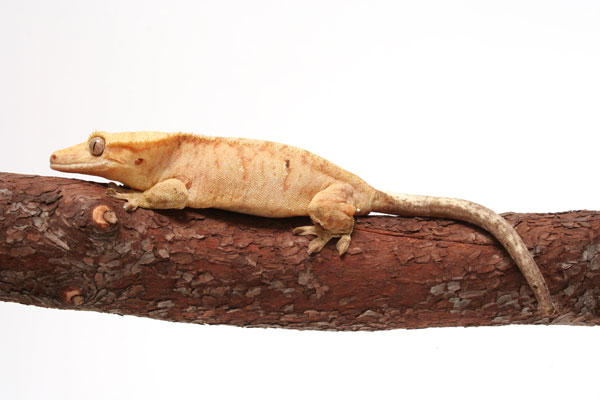
Photo credit: Gina Cioli/BowTie Studio.
Crested gecko.
The ultimate geckos that are great choices for a gecko enthusiast are:
- The eublepharine (eyelid) geckos: the leopard gecko (Eublepharis macularius) and the African fat-tailed gecko (Hemitheconyx caudicinctus)
- The diplodactyline geckos from New Caledonia: the crested gecko (Rhacodactylus ciliatus), the gargoyle gecko (R. auriculatus), the mossy prehensile-tailed gecko (R. chahoua) and the giant New Caledonian gecko (R. leachianus)
- From the wide-ranging Gekkonidae family: the Tokay gecko (Gekko gecko); the Madagascar ground gecko (Paroedura picta); and the day geckos from Madagascar, the giant day gecko (Phelsuma grandis) and the beautiful neon day gecko (P. klemmeri).
Leopard Gecko
Let’s begin our adventure with one of the easiest geckos to keep. The leopard gecko (E. macularius) is the gecko gold standard in herpetoculture, with a long list of reasons why it is an ideal beginner gecko. Many of the basic principles of keeping leopard geckos apply to all of our ultimate geckos, so we will discuss them in detail here.
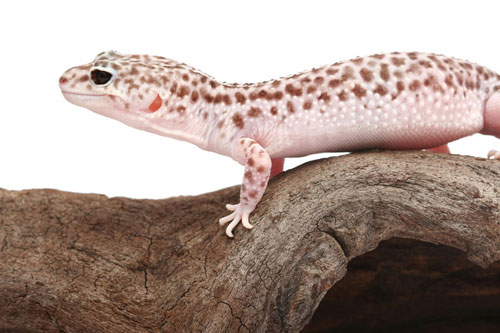
Gina Cioli/I-5 Studio
A snow leopard gecko.
Ranging from western India to Afghanistan and Iraq, the sturdy leopard gecko is recommended as a first gecko because of its sturdiness and the ease of care that is necessary to keep it healthy. It is a nocturnal, terrestrial lizard of considerable size, measuring up to 10 inches (though 7 to 8 inches on average) and weighing up to 150 grams (with an average of about 50 grams). Males are typically larger than females and are heavier boned. A leopard gecko’s life span is long, ranging from 15 to up to 30 or more years in captivity!
The leopard gecko’s size, tolerance of handling, and gentle disposition makes it an ideal pet for children ages 8 years old and up. There is a dizzying array of morphs available, exhibiting many colors, patterns and even different eye colors (with red eyes appearing in the RAPTOR/APTOR strains by Ron Tremper). Leopard gecko tails do come off when exposed to stressful situations, such as an aggressive terrarium-mate or rough handling. They do regenerate in a typical “turnip” shape that is plump, yet different looking than the original tail.
Leopard gecko setups can consist of a glass terrarium with a screen top or well-ventilated plastic tubs, such as those manufactured by Sterilite. Terrariums should be 10 gallons or larger and need to be at least 1 foot tall. Plastic tubs should be at least 16-quart capacity, with a well-fitted lid (solid plastic lids that may come with the tubs should be modified to allow proper ventilation). Setups of this size can house an adult combination of a male and two females, or three adult females as long as they are of similar size. As with most geckos, males cannot be put together because they may fight to the death. Greater numbers of juveniles can be housed in these setups as long as they, too, are of similar size.
Read More: Leopard Gecko Heating and Care
Each gecko should have its own secure, close-fitting hiding place (a good rule of thumb for all geckos). At least one hide must be available in the warm area of the setup and another in the cool area (see below). Also provide at least one moist hide, with moist vermiculite and/or moss inside to assist the gecko with shedding. Terrarium furniture may consist of rocks or pieces of wood, anchored as necessary with glue to prevent tipping and crushing of the geckos. Small live or plastic plants may also be used. Substrate can be simple, such as newspaper, paper towels or reptile carpet. Avoid ingestible substrate, such as sand and pea gravel. Leopard geckos are curious and may ingest more than they can digest.
The leopard gecko terrarium should have a basking site at one end that reaches 86 to 88 degrees Fahrenheit, with a cool area at the other end in the 70-degree range. Temperature can drop into the low 70s at night. Several options are available to heat the terrarium. Infrared or low-wattage incandescent lights are good choices for heating as well as UTHs (under-tank heaters).
Ultraviolet lighting is optional for this nocturnal lizard, though it can be used if live plants are in the terrarium. Lights should be turned off at night.
Leopard geckos are exclusively insectivorous. They should be fed a diet of commercially available insects, such as mealworms, super worms and crickets. Crickets should be 90 to 95 percent of the gecko’s head size — an adult should be fed an approximately 3-week-old or 3/4-inch cricket. Wax worms should be given only occasionally because of their high fat content. Insects should be gut-loaded (fed nutrients) and supplemented with a reptile-specific supplement containing calcium, vitamin D3 and other essential vitamins and minerals, such as phosphorus and vitamin A (or the pre-cursors to make vitamin A). Provide a shallow water dish for drinking.
African Fat-Tailed Gecko
The African fat-tail(H. caudicinctus) may be considered the leopard gecko’s cousin from Africa. They share many characteristics, such as size, shape, weight, terrestrial and nocturnal behaviors, and a long life span of 15 or more years. The fat-tail’s natural wild form is a banded or striped-and-banded morph. In recent years, morphs have increased to almost as large a number as their leopard gecko cousin’s, including albino, patternless, white-out, Zulu, zero, oreo and ghost, to name a few.
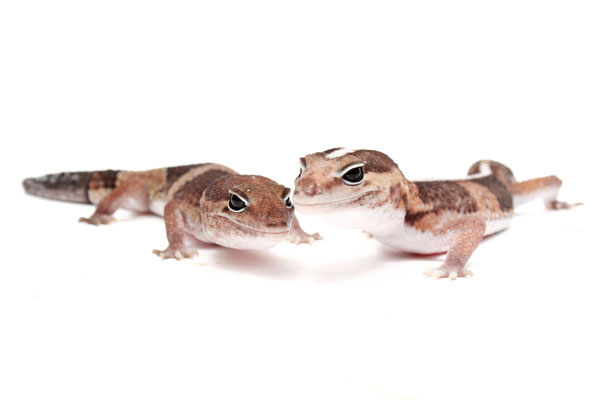
Photo credit: Gina Cioli/BowTie Studio
African fat-tailed geckos.
Fat-tails, too, are easy to keep and it’s fairly easy to find captive-bred specimens. They are also mild-mannered and tolerant of handling.
The terrarium setup for an African fat-tailed gecko can be the same as that described for the leopard gecko, though the moist hide box is even more important for a fat-tail because it is from a moister environment than the leopard gecko. A daily misting is required to achieve a proper humidity level of 70 to 80 percent. A moisture-retaining substrate, such as peat moss or orchid bark (medium grade to prevent accidental ingestion) can be used to increase humidity.
The African fat-tail’s feeding regimen is the same as the leopard gecko’s, except this gecko seems to prefer crickets over mealworms. It may also accept commercially available cockroaches, such as Dubia or Madagascar hissing roaches
Crested Gecko
The crested gecko (R. ciliatus) is also a great entry-level gecko with many ultimate-gecko qualities, such as beauty (many morphs), longevity (15 to 20 years) and ease of care.
Once thought extinct, this charming, soft-skinned gecko with the big eyelashes appeared during a rainstorm in New Caledonia in 1994 and pleasantly surprised everyone! Crested geckos have gentle dispositions that allow them to be handled, and they are hardy, making then a good choice for a first gecko.
The crested gecko is an arboreal, nocturnal gecko with a wide body and large head. Specimens measure approximately 4 to 5 inches without the tail, and can weigh an average of 35 grams when they are sexually mature at 15 to 20 months. Crested geckos’ tails do come off when they are exposed to a stressful situation, and they do not regenerate. Those missing their tails are known in the hobby as “frog butts” because their rear ends look like a frog’s. Tailless crested geckos can live perfectly normal lives, so there is no cause for concern if one’s tail is lost.
The arboreal, tropical crested gecko needs a vertically oriented terrarium. An adult should be kept in a 20-gallon terrarium or larger, and multiple females may be kept with one male, but not with two males because they will fight. Several manufacturers offer tropical kits that include a suitably tall terrarium (18 inches long, 18 inches wide and 24 inches tall) with front-opening doors. They also include accessories such as temperature and humidity (hygrometer) measuring devices, substrate, food and water dishes, artificial plants and foam terrarium walls. If you prefer the do-it-yourself method, buy an arboreal terrarium without the kit and create a custom jungle look with real plants and vines (there are also nice artificial vines available, as well as real grapevine), bamboo, and cork bark walls and tubes.
Hiding places are important, and bamboo and cork bark tubes are a favorite of crested geckos. At least one long piece of bamboo, cork bark or PVC pipe should be placed diagonally across the terrarium. Substrate can be a peat moss and/or orchid bark. If you use orchid bark, the pieces must be larger than the gecko’s mouth to avoid accidental ingestion.
You may also go the simplistic route and use an all-screen cage or 20-gallon plastic Sterilite-type tub with a screen top. Some crested gecko enthusiasts do not use substrate with these more basic setups, as substrate is not critical to an arboreal gecko that spends little time on the ground.
A temperature range in the upper 70s to low 80s during the day works best. Temperatures can drop into the low 70s at night. If you need to heat the terrarium to reach the proper temperature, apply the same techniques as those used with a leopard gecko enclosure.
Ultraviolet lighting is optional because a diet that includes proper vitamin supplementation (again, seek recommendations from the person selling you the gecko) makes UV lighting unnecessary to maintain your crested gecko’s health, although it may be used for live plants in the terrarium. Lights should be turned off at night.
Feeding crested geckos is easy with the advent of Repashy’s Crested Gecko Diet, a commercially available fruit-flavored protein diet supplemented with vitamins and minerals. This is an excellent choice as a dietary staple for your crested gecko. It is mixed 2 parts water to 1 part food and offered in a shallow, sturdy dish that cannot be easily tipped over, such as a crock. Replace it with a fresh serving after 24 to 36 hours. Fruit purée may also be given to crested geckos, but you must supplement it before feeding.
You may also offer crested geckos commercially available insects, such as crickets and roaches. An adult crested can easily eat 3-week-old (3/4-inch) crickets; hatchlings can start with 1-week-old crickets. Young crested geckos are enthusiastic insect eaters, but this seems to change as they get older and begin to prefer fruit-based diets. Prepare insect food items with a vitamin and mineral supplement the same way as described for leopard geckos.
Water should always be available in a sturdy, shallow dish. Relative humidity in the enclosure should be at least 50 percent, achieved through misting either by hand or he use of a commercial misting system or humidifier.
Gargoyle Gecko
Another beautiful New Caledonian gecko that does well in captivity is the gargoyle gecko (R. auriculatus). Just like the crested gecko, this beefy-bodied lizard (35 grams or more in adults, 4 to 41/2 inches in length without tail) is tropical, nocturnal, arboreal and can live for 15 to 20 years. It is found in the southern part of Grande Terre, exclusively among scrub brush and clearings of primary forest. At night, gargoyles may be found walking on roads, so at times they are also terrestrial.
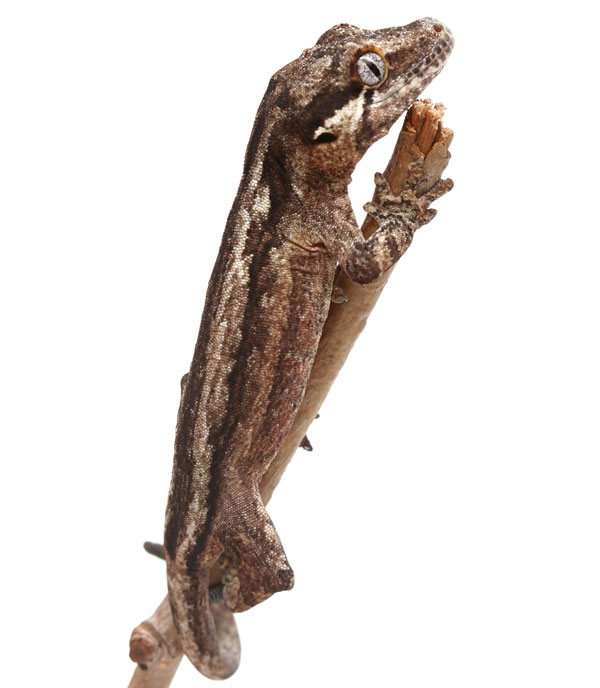
Photo credit: Gina Cioli/BowTie Studio.
Gargoyle gecko.
Gargoyles are captivating geckos because of their unique look. The name “gargoyle” does provide an indication of their intriguing appearance, and they earn it because of the bony protuberances around the head above the ears. Their marbled eyes are also fascinating. Many morphs are available, the most common being the reticulated and striped. The red-striped morph is particularly stunning.
Gargoyle setup, care and husbandry is nearly identical to the crested gecko’s, with a few small differences. Gargoyles are not as social with each other or with people, so approach handling with caution. They may bite, and they have sharp teeth. They tend not to hang out together in the terrarium, so lots of uncluttered space is preferred. Grape vines for climbing work well for gargoyles in this type of setup. Unlike the crested gecko, if a gargoyle’s tail is lost, it will regenerate. Finally, some specimens may be more insectivorous than others. Its diet is essentially the same as the crested gecko’s, though more insects may be consumed.
Mossy Prehensile-Tailed Gecko
In recent years, the mossy prehensile-tailed gecko (R. chahoua) has soared in popularity among gecko enthusiasts. This striking New Caledonian gecko has a beautiful mossylike patchwork of greens, reds, browns and sometimes whites on the shoulders. It originates from the Isle of Pines, where larger specimens with more distinct patterns are found, and from the mainland of Grande Terre, where it exhibits less distinctive patterning. This gecko’s gold eyes are captivating, and individuals are often quite tame.
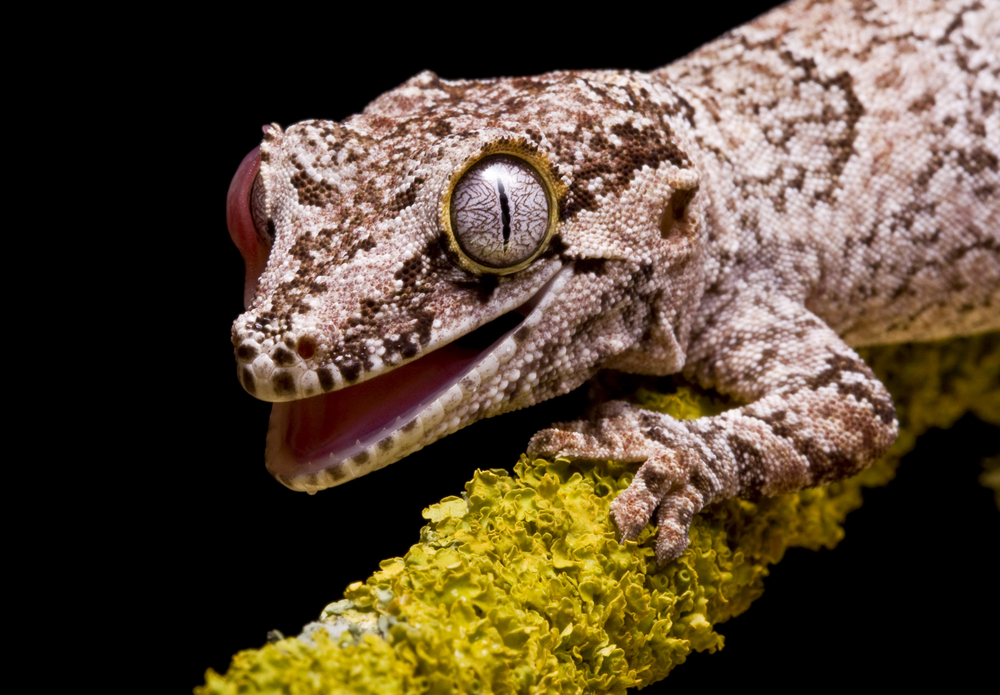
shutterstock/robert king
In recent years, the mossy prehensile-tailed gecko (R. chahoua) has soared in popularity among gecko enthusiasts.
The mossy prehensile-tailed gecko shares many characteristics with the other New Caledonian gecko species previously mentioned. It is also nocturnal, tropical and arboreal, and it has a lengthy life span at 20 to 30 years. Its snout-to-vent length can be as long as 5.7 inches, and specimens may weigh between 40 and 60 grams when sexually mature. Given that the tail only partially regenerates, it is fortunate that they do not readily drop their tails.
Setup and husbandry for R. chahoua is the same as for a crested gecko, with special attention to vertical space and adequate climbing furniture, including grapevine, cork bark and bamboo.
Giant New Caledonian Gecko
The last of our ultimate New Caledonian geckos is the giant New Caledonian (R. leachianus), a favorite among both gecko breeders and hobbyists because of its large size and beautiful coloration. There are two types: the largest form from Grande Terre (R. l. leachianus) and a smaller form, the Henkel’s giant (R. l. henkeli).
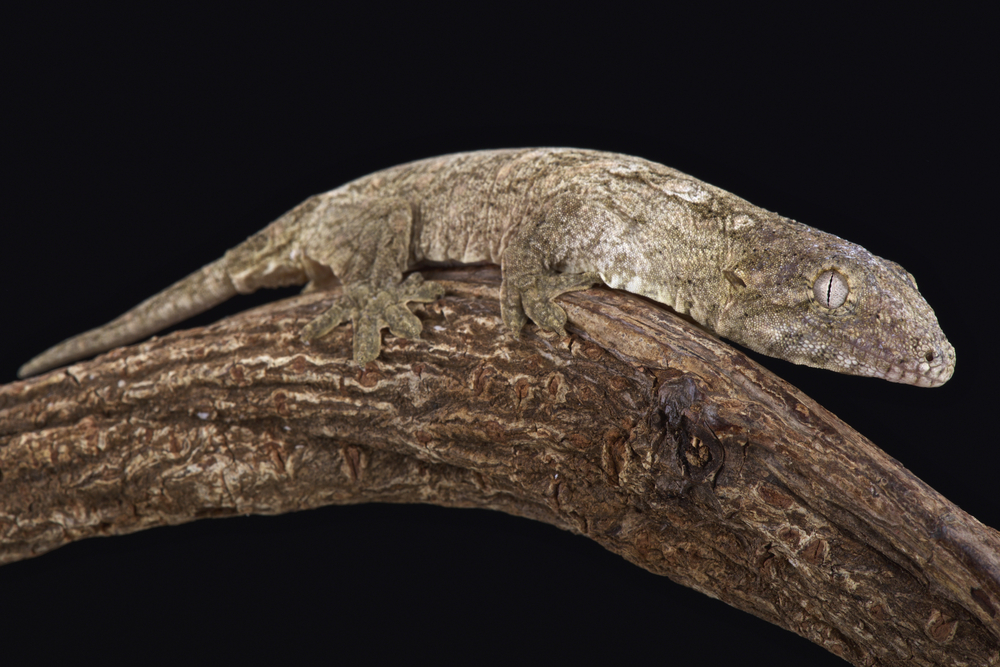
shutterstock/reptiles4all
The giant New Caledonian is one of the largest geckos in the world.
The large size and tremendous strength of the giant New Caledonian geckos makes them a good choice for an experienced gecko keeper, one with a good foundation of Rhacodactylus husbandry knowledge, ideally after having kept crested or gargoyle geckos.
The giant New Caledonian is one of the largest geckos in the world. It can measure up to 13 inches from snout to vent, and Grande Terre specimens can weigh up to approximately 450 grams. It has a large head, thick body and short tail. Many locality-specific morphs exist; most have a green to brown base color with round or checked spots of many colors, including white, pink, green, yellow, red and orange seen in different morphs. This gecko also has one of the longest gecko life spans in captivity: 20 to 35 years.
Terrarium setup and conditions should be similar to that of the crested and mossy prehensile-tailed geckos, except for this gecko the terrarium needs to be “supersized!” A 40-gallon enclosure is a good starting point for a single adult; 50 gallons or larger should be used for a pair. Exo Terra makes a large terrarium that works well and has a two-door front-opening style. It measures 24 inches long, 18 inches wide and 36 inches tall. In New Caledonia, both types live in trees and tree hollows, so offer large branches or bamboo for them to climb on. A large sheet of cork bark is a favorite and is durable enough to support their large size. Select only sturdy plants, as small plants will be crushed by these huge geckos.
Giant New Caledonians should be housed singly or in male-female pairs. House juveniles singly in small terrariums, such as 11/2-gallon Critter Keepers. Juveniles are intimidated by large setups.
There are few insects in the natural range of the giant New Caledonian geckos. Pets will prefer a crested gecko or fruit-based diet and an occasional insect offering. Juveniles may be more receptive to insects than adults. The Grande Terre form is an exception to this generality, as it is known to become more insectivorous with age, taking commercial insects, such as large crickets and super worms. It will also accept pink mice.
Tokay Gecko
Now we are off to Asia, India and Indonesia to find our next ultimate gecko, the vocal Tokay(G. gecko). Like the giant New Caledonian gecko, the Tokay gecko is one of the largest geckos in the world. Males can easily reach 14 inches in length and weigh 300 grams or more. The Tokay is also one of the most visually appealing geckos. Bright red spots on a blue-gray body color is the natural variation, but many morphs exist, with various colors and patterns that are highly sought after by collectors.
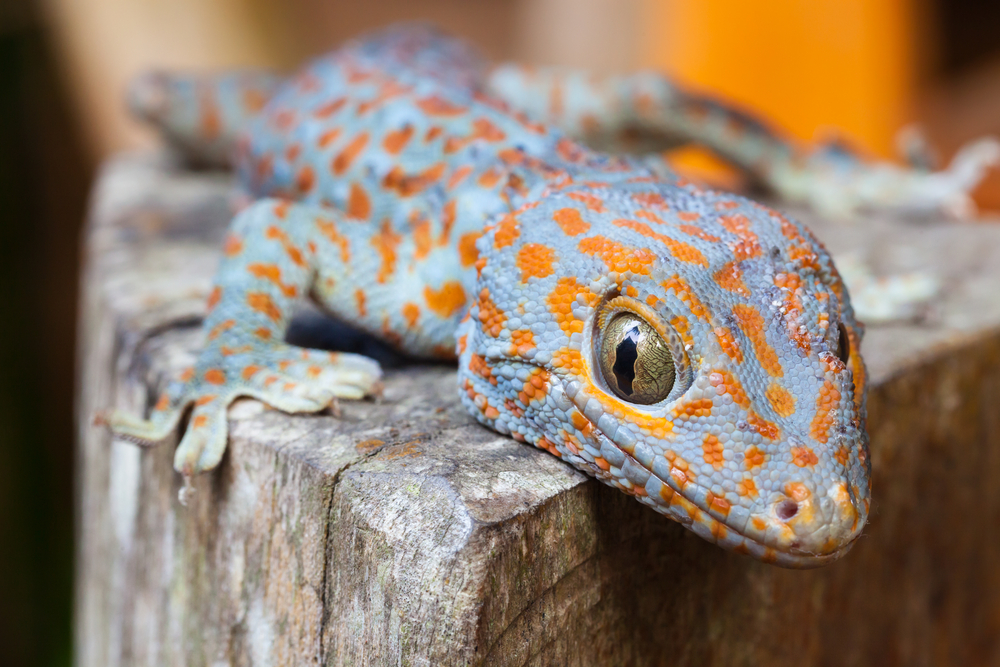
shutterstock/cocos.bounty
Tokay gecko.
The Tokay is arboreal, tropical and nocturnal. It, too, is a long-lived gecko, with frequent reports of individuals living 20 years or more. If lost, its tail will regenerate. The Tokay differs from the giant New Caledonian in that it is very social when it comes to mates and offspring; all live together well in a large terrarium setup, though the usual no-two-males-together rule continues here. Tokays are best kept in male-female pairs or as multiple females. They may or may not tolerate handling, especially if they have not been handled since they were juveniles. Approach Tokays with caution; they can inflict a nasty bite!
Read More: Tokay Gecko Information
Vivarium setup and husbandry is the same as described for the giant New Caledonian gecko, with the exception that Tokays are mostly insectivorous. They will eat any commercially available insects, taking up to 6-week-old crickets as adults.
Madagascar Ground Gecko
We finish the last leg of our ultimate gecko journey in Madagascar. Here we find the Madagascar ground gecko (P. picta). Found in the southern part of Madagascar, these tropical and nocturnal geckos are mostly terrestrial, living under leaf litter during the day and chasing insects at night. They are not large at 51/2 inches, including the tail, and they are highly active and alert when seeking prey.
Madagascar ground geckos have large gold to copper eyes, which add to their appeal. There are two basic morph patterns, banded and striped, though there are also xanthic forms. There are seemingly infinite variations on these morphs.
This gecko is a bit jumpy to handle and is best handled minimally. Its tail does regenerate if lost, which happens most often if individuals are kept in overcrowded conditions. With proper care, Madagascar ground geckos can live six to 10 years in captivity.
Terrarium setup and husbandry is similar to that described for the African fat-tailed gecko. It requires 60- to 70-percent humidity. A moist hide box, though optional, is beneficial. Substrate can be paper towels, peat moss and/or medium-grade orchid bark.
Giant Day Gecko
Another great gecko from Madagascar is the giant day gecko (P. grandis), which is from the lush, tropical northern and northwestern part of the island. The giant day gecko is true to its name, reaching 7 to 12 inches in length. It is diurnal, with a spectacular bright-green body color and red markings on the face and head, including an ever-present red nose-to-eye stripe. Red markings on the back may or may not be present.
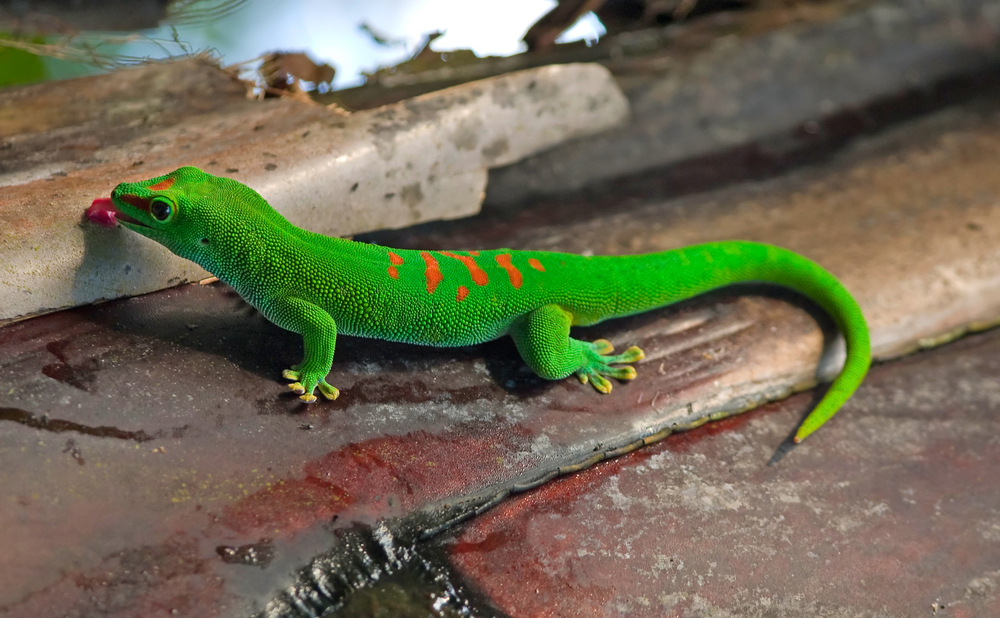
shutterstock/evgeny murtola
Day gecko.
I recommend the giant day gecko as a second gecko, after you have first had experience keeping a leopard or crested gecko. Specimens have been known to live as long as 30 years, with life spans in the teens being the most common in the hobby.
The giant day gecko is an excellent display gecko. It cannot be handled because it does not like it and its skin is delicate. As with most of our ultimate geckos, and all types of day geckos, its tail does regenerate if lost.
Keep giant day geckos singly or in male-female pairs. Terrarium setup is nearly identical to the crested gecko’s, though giant day geckos do best in a glass-and-screen combination, which helps maintain the required 70- to 80-percent humidity, with a bright basking light. A T8 fluorescent will provide the necessary brightness, and a heat source, such as an incandescent light, can be used to heat a basking spot to 86 to 88 degrees during the day. At night, temperatures can drop to the low 70s. Full-spectrum lighting is optional, but compact fluorescents can provide both heating and the bright light all day geckos need to metabolize their food properly. Place at least one piece of 2-inch-diameter bamboo or PVC pipe diagonally across the terrarium, along which the gecko can choose its preferred temperature.
Feeding a giant day gecko is very similar to feeding a crested gecko, except that the giant day gecko is equally insectivorous and frugivorous while the crested gecko leans toward the latter. Giant day geckos prefer crickets to most other commercially available insects, and also do well on Repashy’s Day Gecko Diet or Crested Gecko Diet.
At least once a day, mist the terrarium, as this gecko prefers to drink water off of plants and the enclosure’s walls as opposed to drinking from a water dish.
Neon Day Gecko
Our last ultimate gecko is the small (up 33/4 inches) neon day gecko (P. klemmeri) from northwest Madagascar. Like the giant day gecko, it is tropical and diurnal. It exhibits a beautiful striped coloration of blues and blacks and has a yellow-green head. This striking gecko has an engaging personality and will tolerate a limited amount of handling, which is unusual for a Phelsuma species. It is a great day gecko for someone who has previously kept a giant or other type of day gecko, and its life span in captivity ranges from 10 to 12 years if kept in optimal conditions.
The setup for a neon day gecko is similar to the giant day gecko’s. It can be kept in a smaller terrarium, such as a 10-gallon tall, and smaller-diameter bamboo is needed. A basking spot between 85 and 95 degrees should be provided. It’s best kept in male-female pairs, though “hareming” — keeping one male with multiple females — has been done successfully. Feed the same foods as described for P. grandis, though adult neon day geckos require 2-week-old crickets. Fruit flies are also accepted.
Now that you’ve seen all the wonderful choices, where will you start your ultimate gecko journey?
Julie Bergman is the owner of Gecko Ranch, LLC and has been breeding many gecko species for more than 20 years. She is a frequent contributor to REPTILES magazine and is the author of the Advanced Vivarium Systems book, Geckos. Visit her website at geckoranch.com.


